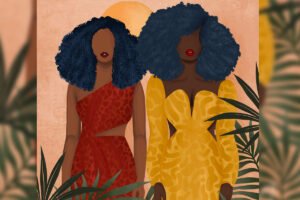
It’s Wednesday, January 6th, 2021, and as I write this call to action for philanthropists, foundations, and funders, my fingers are visibly shaking. I am a Black woman. Period. I share this because it cannot be separated from my experience and it will provide context to this statement.
I am also an executive director of a nonprofit organization, Nonprofit Prince George’s County, a coalition of human services groups. This organization has been around for 25 years and was incorporated in 2001. I share this to show that our organization has a long history and is rooted in the community. We serve Prince George’s County, Maryland.
Let me share that our county is situated right outside of Washington, DC, and borders the nation’s capital. We are a “majority melanated” county, with our demographic makeup being 64-percent Black, 16-percent Latinx, and 14-percent white. Black and Brown people make up 80 percent of our population. We have higher rates of education, income, and homeownership in comparison to other areas with high concentrations of Black and Brown people. However, our county does not possess the wealth of our thriving neighboring counties like Montgomery County, Maryland and Arlington County, Virginia. What is more telling are the major disparities that still exist.
I am not new to leadership. I am. however, a new nonprofit executive director. Coming into my role at the start of the COVID-19 pandemic, I literally hit the ground running, nonstop. Transitioning leadership, learning the landscape, evaluating need, and pivoting quickly to respond were skills I was required to utilize at record speed. There was little time to process; we had to simply move. Our community was hurting, and it looked like there was not an end in sight.
And then, on May 25th, the world watched as 46-year-old George Floyd was murdered by police officers in Minnesota. Then, video was released showing that on February 23rd, 25-year-old Ahmaud Arbery was murdered by two vigilante white men in Georgia. Then, we saw body-cam footage from just weeks earlier on March 13th, when 26-year-old Breonna Taylor was murdered by police officers in Kentucky. Black people, who have lived with the possibility of these outcomes as our daily realities, were not surprised—but we were outraged. And then something else happened.
While COVID-19 forced the world to sit still, eyes were glued to screens and witnessed again, again, and again the very life being taken from Black bodies intentionally, callously, with such cruelty and impunity—and at least some could not pretend that racism did not exist any longer. They could no longer shut their eyes, like watching a horror movie and waiting for the brutal and scary part to pass, only opening their eyes when it was safe for them to do so.
Once again, the country was a powder keg of racial tension that exploded. People of all races, ethnicities, and genders showed an outpouring of disgust and outrage. Even businesses felt compelled to issue statements around racial equity and their commitment to it. Funders to nonprofits did, too.
Meanwhile, our organization has continued to struggle. Since mid-March, I have worked every single day, with Thanksgiving being my first day off. I have ignored the mental health deterioration of myself and team in an effort to still show up and produce for our nonprofits and community. I dismissed the self-imposed exhaustion from working Sunday to Saturday, from late nights to early mornings, as only a short-term need that now has no end in sight.
Then, there is the personal. As a mother to a busy two-year-old. I had no time left for him. With little or no childcare options, I juggled simply keeping him quiet in order to complete a never-ending laundry list of tasks. And when that did not work, I would fall apart in a heap of frustration and tears. Sometimes, I was unsure whose sobs were loudest, his or mine. He is two, I am not. I am forcing him to be someone that he is not. He is simply surviving, far from thriving. Every day, I choose my job over my child, and in every way it feels wrong. He deserves better.
Meanwhile, I am running an organization with barely two full-time employees and several dedicated part-time team members, when we realistically need at least 10 full-time positions to run with an effective, albeit still skeletal, staff. Even so, our virtually nonexistent staff has had no sense of security. Our salaries, well below the median for both the position and region, are our reality. Partial health care, no company life insurance or retirement plan offered or matched—all while working extensive hours—are facts.
I often think about my sheer survival, lamenting that if something happens to me, my child will be left with nothing. While many other nonprofits talk about promoting self-care practices to address the mental toil and anguish that the dual viruses of COVID-19 and racism bring, we are not immune to this. We often hear that you cannot pour from an empty vessel. Well, my vessel is not just empty, it is bone dry. Yet, this is not just a job; this work is at the very core of my being. This is my community. This is my life.
Sign up for our free newsletters
Subscribe to NPQ's newsletters to have our top stories delivered directly to your inbox.
By signing up, you agree to our privacy policy and terms of use, and to receive messages from NPQ and our partners.
Our organization’s struggle has not been due to lack of ability, innovation, or commitment. We have all of that. Quite frankly, I possess all of the aforementioned qualities. I am creative, bright, and determined, and I lead with authenticity, compassion, and grace. I am a truth-teller, even when it comes to myself. Since coming into this position, I have developed and implemented some impactful programming, including the Collective Community Check-In, Courageous Conversations, the I-2 Lunch & Learn workshop series, and the Nonprofit Navigator experiential internship program. We have partnered with the county executive’s office on their Stand Up & Deliver program to provide more than 10,000-plus meals to food-insecure residents. We have provided more than 200 nonperishable food boxes to seniors in need.
We have struggled due to lack of funding—funding for capacity building to operate at our potential. The benevolence that we have been seeing all over the news and as part of every major public affairs campaign didn’t reach us. It didn’t reach the majority of our community members and nonprofits that are on the ground doing this work in real time.
In an organization designed to support our entire nonprofit community, we are a reflection of their immediate reality. Over 80 percent of health and human service nonprofits in Prince George’s County operate on an annual budget of $25,000 or less. This was the reality before COVID-19, and it certainly has only worsened. Many of us doing this work have sacrificed our own health to keep going in the face of adversity and the possibility of our doors closing. Since July, we have applied for more than $1 million in grant funding and were not awarded any.
I do not want to be a martyr to the cause. I want to do good and do well.
A recent report commissioned by the Ms. Foundation was titled Pocket Change: How Women and Girls of Color Do More with Less. The report provides a baseline understanding of philanthropic funding and investment in women and girls of color throughout the US and its territories. The report found that total philanthropic giving averages out to just $5.48 per year for each woman or girl of color in the US—and the amount in the South is the lowest in the nation, less than half the national average.
Women and girls of color are frontline leaders and organizers in the social change movements that have paved the way for a more equitable and just democracy. As seen during this most recent election, women of color mobilized their communities as they have done throughout history. They are the primary constituency most impacted by inequity and live at the intersection of multiple systems of oppression, including white supremacy, patriarchy, colonization, and unbridled capitalism. And yet their work is still under-resourced.
If philanthropists and foundations want to bring about long-lasting and sustainable change and address racial inequity, fund us. Fund us with unrestricted dollars or with significant capacity building grants. Fund not just us, but fund others that are doing amazing work but do not have the capacity to tell their stories. We know the research. This information existed 100 years ago, and it exists today. When your capacity is limited, providing quantitative data is not easy, but qualitative data exists in the anecdotal stories of the impact of the work. Fund us without the demand for extensive research and data; it has always existed. I am the expert of my experience and in my community.
As we move into a space of transforming what has been into what will be, consider doing more than just issuing a statement. If you want to support Black-led nonprofits, focus on capacity building and infrastructure. Do the work to find the hidden gems doing good and not well in their communities. Transform your thinking.
I believe that budgets are a reflection of organizational values and priorities. What does your budget reflect? Give more than typical. And be aware that in communities that have been historically oppressed and marginalized for more than 400 years, there is no such thing as giving too much.
Give so that the capacity building and sustainability is in place for at least a decade. It took much longer than that to create the wealth disparities experienced by my community.
Give so that we can hold space to process the trauma of the atrocities of what I am witnessing now. The storming of the US Capitol by majority white-bodied domestic terrorists was horrifying. I shudder to think what would have happened if they were in Black bodies. I must process all of this and still show up to work tomorrow, because our lack of capacity will not allow me to take the day off.
I need to heal, I am exhausted, I am not okay, and I am the teller of my own story.











